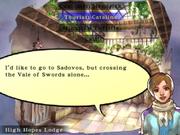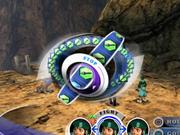Square is definitely a sequel-driven company. The RPG magnate has flourished for years primarily on the strength of its longest running and most popular series, Final Fantasy. Of course, Square's stable of big names also includes hits like the Chrono and Mana games, all of which have proven to be quite popular. And then there's SaGa. The offbeat RPG series has always been a bit of an enigma in Square's lineup--while most of the company's other big games adhere to tried-and-true formulas, the typical SaGa game is in fact anything but typical. Series fans will be glad to hear this trend of unusual design and production continues with the newest installment, Unlimited SaGa. They won't be so glad, though, when they find out how poorly the game's elements actually work together as a whole.

Like the previous games in the series, Unlimited SaGa presents you with a sizeable and diverse cast of playable characters (seven, in this case). The group includes Laura, a tough former pirate; Mythe, an inventor and playboy; Kurt, a wayward knight; Judy, a 10-year-old witch; Ventus, a goofball mail carrier; Ruby, a teenage fortune-teller; and Armic, a squirrel-like chapa tribesman. You can begin a new game with any of the seven characters, and each one has his or her own back story that propels him or her onward into the game. For example, Ventus starts out seeking the killer of his famous older brother, Briza, while Kurt's quest begins as he searches the world for the meaning of a mysterious ancient gauntlet he wears. Each character's storyline is entirely unique, although they sometimes become intertwined--you'll occasionally run into one of the other playable characters during your questing, and you'll often travel with other characters aside from the core group of seven. The storylines range from vaguely interesting to utterly bland, and given the way the game advances the plot (more on that later), they're often more confusing than anything.
If you're a fan of more-traditional RPGs like Final Fantasy and Chrono Cross, the presentation and gameplay of Unlimited SaGa will likely come as quite a shock. The flow of the game, from interactions in towns to moving around dungeons and the world map, is very different from typical RPG fare. For one, all town scenes are represented simply by static backgrounds, and you move to a building by highlighting it with a cursor. Interactions with townspeople, and indeed all the dialogue sequences in the game, play out with mere static character portraits and comic-book-style text bubbles. When you're tired of moving a cursor around the town background, you can head to the inn and see what adventures can be undertaken. Sometimes these adventures tie into your character's storyline, but other times they serve no apparent purpose, and after embarking on one you often have to wonder exactly why you're doing what you're doing. The whole process, which is meant to advance the game's plot, ends up being incredibly nonsensical.
The oddities don't stop once you reach one of Unlimited SaGa's fields or dungeons. If you thought you'd be granted some freedom of control and movement outside of the towns, you can think again--the game's field scenes play out like some bizarre RPG board game. Your character is represented by a tiny static sprite, and you move in hops along preset paths that are presented to you. Each movement may present some form of obstacle or curiosity--you can be attacked, encounter a pitfall, or discover a treasure chest, for instance. None of these are visible on the board, however, so you'll end up stumbling blindly into things quite a bit. This system of exploration, which doesn't actually let you explore much at all, comes off as stilted and constraining. It's also horribly plodding and makes the movement portion of the game feel like a chore.
Unlimited SaGa's combat system doesn't do much to alleviate the irksomeness of the rest of the game. In a strange twist on the RPG formula, you have both hit points and life points keeping you alive, with the HP simply serving as a buffer between enemy attacks and your LP. Once your HP is gone, attacks will start to cut into your LP, and only when your LP reaches zero will you die. Since your HP can be freely replenished between battles, surviving is simply a matter of making it out of a battle alive so you can "rest" and get back up to full health. You can queue up your characters' attacks during a battle, and when each attack comes up, you're presented with one of the game's new features: the "reel." This is a slot-machine-like wheel with a variety of icons on it, and you'll have to stop the wheel with a timed button press to determine the strength of your attack. Having to depend partially on timing and luck to win battles can get pretty annoying. The game does feature a degree of character customization, but it's all incredibly obscure and just makes one long for the simplicity of a Final Fantasy game.

Visually, your mileage with Unlimited SaGa will vary depending on your opinion of its method of presentation. On one hand, the hand-painted character portraits and backgrounds in the game are quite well done. On the other, they aren't animated--everything is entirely static. The only place you get anything resembling modern graphics is in the battle sequences, which feature sprite-based characters and rudimentary 3D backgrounds. So if you like the game's art style, you'll probably enjoy looking at it for a little while, but if you're looking for flashier or more-modern graphical fare, Unlimited SaGa won't be the slightest bit exciting. The game's catalog of sound effects is understandably limited, since little of it plays out in anything like an action scene, and the voice acting ranges from decent to really bad. Unlimited SaGa's soundtrack, however, is stupendous. Composed by Final Fantasy X alumnus Masashi Hamauzu, the music far outshines the game itself. Fans of previous Square musical efforts would do well to seek out the Unlimited SaGa soundtrack even if they pass on the game, which is advisable.
In the end, Unlimited SaGa is simply the flawed sum of its disparate parts. Every aspect of the game, from the combat mechanics to the movement to the technical execution of the graphics, is lacking in some regard, and when you add these elements together, you get a game that's simply unpleasant to play.